How Long Do Lumps Stay In The Skin After Scig
![]() ASCIA PCC SCIg Full general information 2021 260.85 KB
ASCIA PCC SCIg Full general information 2021 260.85 KB
Immunoglobulins (commonly known as antibodies) are used to treat adults and children with principal allowed deficiencies (and other medical conditions), who are unable to brand plenty of their ain antibodies, or who have antibodies that don't work properly.
Replacing these antibodies helps to protect against infection and tin can prevent long term damage from ongoing infections (such every bit chronic lung illness).
How are SCIg infusions given?
Subcutaneous immunoglobulin (SCIg) infusions are given by slowly injecting purified immunoglobulin into fatty tissue just underneath the skin.
SCIg can be given at home using:
- Mechanical infusion pumps - spring loaded, or battery powered.
- Rapid push button - a manual method that does not require a pump, with the infusion pushed by hand through a syringe.
What are the risks associated with SCIg?
SCIg is very well tolerated and condom. SCIg is fabricated from plasma (the liquid office of blood), which comes from blood donors who are checked to brand sure they are healthy and practise not accept certain infectious diseases.
Manufacturers besides include steps in the processing of blood or plasma that inactivate or remove viruses.
This means that there is an extremely low (almost zero) chance of blood borne viruses, such as Hepatitis B, Hepatitis C, HIV and Variant Creutzfeldt-Jakob illness (also chosen "mad moo-cow disease").
Reactions or side furnishings to SCIg include:
-
Mutual injection site reactions such equally redness, swelling and itching These are commonly mild and go away over a day or two. Reactions are generally worse with the start few infusions and get ameliorate over time. Most itching is resolved by slowing the infusion.
-
Uncommon side effects such as headache, feeling hot, nausea, diarrhoea, sore throat, rash, increased coughing and back pain. These are usually mild.
-
Extremely rare and serious side effects such as allergic reactions, kidney issues or blood clots.
If a reaction occurs you must inform your nurse specialist or doctor as soon as possible and get communication before having any more infusions.
For information about managing reactions run across pages 6 and vii of this document.
What needs to be done earlier starting SCIg?
Before you offset on SCIg, your nurse specialist will provide you with data and grooming on how to give SCIg at dwelling.
You lot will need to sign a consent form to say that you empathise the need for treatment and the hazard of reactions that may occur with the handling.
Choosing a SCIg infusion site
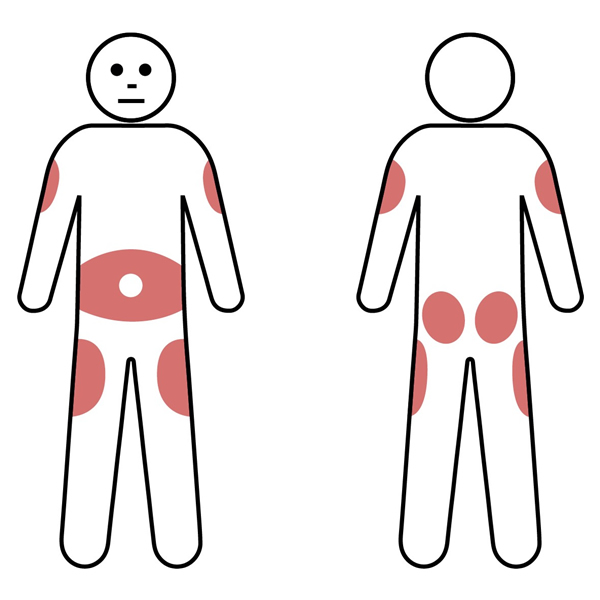 Using the same site for infusions can assistance reduce the amount of local swelling and redness that tin can occur after an infusion.
Using the same site for infusions can assistance reduce the amount of local swelling and redness that tin can occur after an infusion.
However, multiple (2-3) sites can be used on a rotating basis, according to patient preference.
SCIg injection sites are ordinarily in the lower abdomen, but the outer border of the thigh, buttocks or back of the upper arm tin can also be used.
Avoid bony areas such as the hips.
When using the lower abdomen in adults and most children, the needle should be inserted at to the lowest degree 5cm abroad from the abdomen button.
If using more than 1 site at a time, make sure they are at least 5cm autonomously.
Note: Exercise non insert the needle where the skin is scarred, bruised, broken or inflamed (such as eczema).
Before you infuse, have your equipment fix: see checklist world wide web.allergy.org.au/patients/immunodeficiencies/scig-therapy-equipment-checklist
An infusion checklist is also available www.allergy.org.au/patients/immunodeficiencies/scig-infusion-checklist
It is recommended you have a cold pack, a non-drowsy antihistamine and an analgesic (pain medication) available in case of a mild reaction.
Examples of SCIg infusions are shown below.
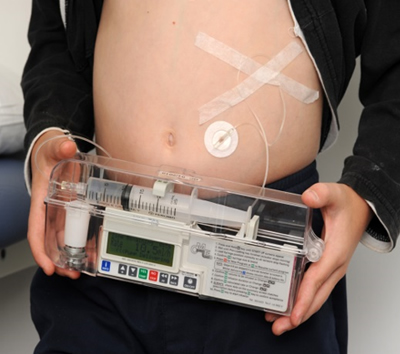
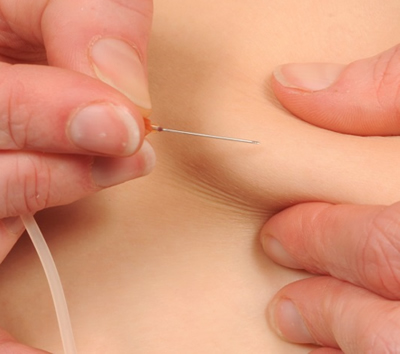
Documenting the SCIg infusion
The details of each infusion session must be recorded in a SCIg Infusion diary. Your nurse specialist or doctor will give you a SCIg infusion diary and volition explicate the information yous volition demand to record.
Completed diaries must be available for review by your nurse specialist or dr. at each outpatient clinic visit.
Ordering, collection, transport and storage of SCIg
-
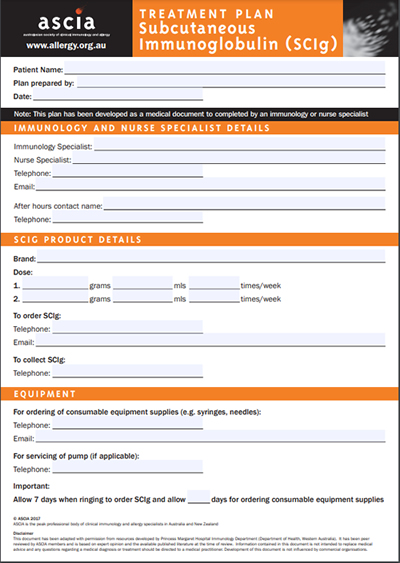 Make sure you order SCIg product in accelerate - follow your SCIg treatment plan.
Make sure you order SCIg product in accelerate - follow your SCIg treatment plan. - Your nurse specialist or md will explain how and where to collect the SCIg product and this should exist included in your SCIg treatment program.
- SCIg must be kept cool (2-eight°C) for the journey dwelling house:
![]() When collecting SCIg yous must provide a absurd box or absurd bag big enough to transport vials with an icepack. Ensure SCIg vials are not in direct contact with the ice, to avoid possible freezing.
When collecting SCIg yous must provide a absurd box or absurd bag big enough to transport vials with an icepack. Ensure SCIg vials are not in direct contact with the ice, to avoid possible freezing.
![]() Accept SCIg home immediately and place in a sealed container in the central part of the refrigerator.
Accept SCIg home immediately and place in a sealed container in the central part of the refrigerator.
- Storage temperatures are dependent on product choice - your nurse specialist will tell y'all how to shop the SCIg production you are using. Even so, the post-obit principles should exist followed for all SCIg products:
![]() Store SCIg in original packaging until needed, and protected from lite
Store SCIg in original packaging until needed, and protected from lite
![]() Shop SCIg between two°C and 25°C and avoid extreme temperatures.
Shop SCIg between two°C and 25°C and avoid extreme temperatures.
![]() Do not freeze (never store SCIg below 2oC) and do not use SCIg that has been frozen.
Do not freeze (never store SCIg below 2oC) and do not use SCIg that has been frozen.
![]() Exercise not store SCIg in the door or bottom storage unit of the fridge.
Exercise not store SCIg in the door or bottom storage unit of the fridge.
![]() Exercise non store SCIg most the cold outlet from freezer to refrigerator (in combination freezer-fridge) .
Exercise non store SCIg most the cold outlet from freezer to refrigerator (in combination freezer-fridge) .
![]() Do not shake SCIg.
Do not shake SCIg.
If you have a power or refrigerator failure and are unable to keep SCIg refrigerated:
- Contact your nurse specialist as soon every bit practical for further communication.
- If fridge is notwithstanding cold, go on your supply in the refrigerator.
- If the fridge is no longer cold, identify SCIg in your ship cool box or absurd bag with an ice pack.
Product from a vial is for single use merely:
- Once opened, use as before long equally possible as the production does not contain preservative.
- If yous are unable to complete your infusion within the recommended time (which varies betwixt ii and 4 hours for different products), any unused product should exist discarded.
- All SCIg vials must be disposed of in the sharps container provided past your hospital. These should exist returned to the hospital or pharmacy. Do non discard SCIg in your household bin.
SCIg Products
SCIg Product - Hizentra®
- Once removed from the refrigerator, shop Hizentra® between 2°C and 25°C and use upward until decease appointment.
- Hizentra® is a clear, pale yellow to calorie-free brown solution. Do not use if the solution is cloudy or contains particles.
- Hizentra® infusions to be completed inside four hours of starting infusion.
- For instructions become to https://www.nps.org.au/medicine-finder/hizentra-vial
SCIg Product - Evogam®
- Once removed from the refrigerator, store Evogam® between ii°C and 25°C and use within two weeks.
- Evogam® is a clear, pale-yellow to calorie-free brownish solution. Practice non utilise if the solution is cloudy or contains particles.
- Evogam® infusions to be completed within four hours of starting the infusion.
- For instructions go to https://world wide web.nps.org.au/medicine-finder/evogam-solution-for-injection
SCIg Production – CUVITRU®
- Tin exist stored between 2ºC and 25ºC. Does non use later on the expiry date.
- CUVITRU® is a clear and colourless to a pale yellow or low-cal brown solution. Do non use if the solution is cloudy or contains particles.
- It is advised that CUVITRU® infusions exist completed inside two hours of starting the infusion.
- For instructions go to https://www.nps.org.au/medicine-finder/cuvitru
Checking SCIg vials earlier an infusion
All SCIg vials should be checked for the following prior to an infusion:
- Decease date on the vial - Practise Not Use if out of date
- Protective cap is in identify - Do Not Utilize if seal is broken
- Solution in vial is clear - Exercise Non Apply if solution is cloudy, discoloured or contains particles
Contact your nurse specialist if any of the above happens.
If unwell, significant or breastfeeding
Contact your physician or nurse specialist for farther advice if:
- If you lot are unwell with a fever
- If you doubtable you are significant, or if you are breast feeding.
Your doctor and nurse specialist will work with you to develop a program for who, how and nether what circumstances you will need to contact someone if you lot or your child have an agin reaction.
SCIg and vaccinations
Some immunisations may not be required while on SCIg. Discuss this with your medico.
Travelling with SCIg
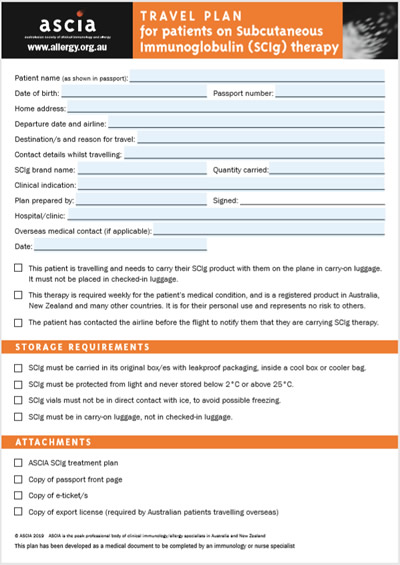 Travelling with SCIg requires planning well beforehand. A dose of Intravenous Immunoglobulin G (IVIg) before you travel may be a convenient alternative option.
Travelling with SCIg requires planning well beforehand. A dose of Intravenous Immunoglobulin G (IVIg) before you travel may be a convenient alternative option.
For shorter periods of travel, yous may give the SCIg doses due every bit extra SCIg infusions before and after the trip.
Speak to your medico or nurse specialist for communication well before travelling, especially overseas, equally you may require an export permit.
When planning a trip:
- Get a travel plan or letter of the alphabet from your nurse specialist or physician and have this and your handling plan in your mitt luggage.
- When flying, take SCIg with you on the plane in your hand luggage and don't forget to collect it before you exit the plane. It must not be put into checked-in luggage
- It is of import to go along SCIg at an appropriate temperature for your product at all times (bank check product information, and if uncertain bank check with your nurse specialist). Never store SCIg below two°C or in a higher place 25°C.
- Pack pain medication and a non-drowsy antihistamine in case of adverse reactions.
- Pack enough consumable equipment
- Pack enough SCIg for the trip and store this in original packaging until needed, in a absurd box or cooler bag.
Managing side effects of SCIg
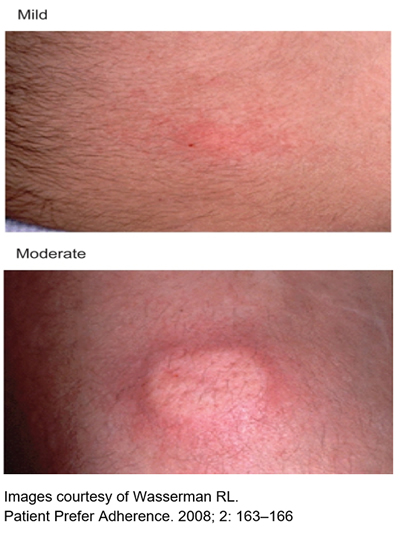 Common reactions at the injection site include mild or moderate swelling (egg sized lump), 'hardness', blanching and redness at the infusion site. These local reactions are normal and short lived (usually gone by the next day). They are more mutual in people who have merely started SCIg, especially in the beginning few months.
Common reactions at the injection site include mild or moderate swelling (egg sized lump), 'hardness', blanching and redness at the infusion site. These local reactions are normal and short lived (usually gone by the next day). They are more mutual in people who have merely started SCIg, especially in the beginning few months.
Using the same site for SCIg infusions can aid to reduce the amount of local swelling and redness that tin occur after an infusion. Over time, the skin will "get used" to the repeated infusions, and local reactions will lessen. Near people starting time to notice a decrease in local reactions after about 8-10 weeks.
If an injection site reaction occurs:
- Practise not rub or scratch the site. Use gentle massage and warm or cold pack (according to your personal preference) to reduce discomfort. Report unusual site reactions, such as extreme pain or discomfort, blistering or spreading redness to your nurse specialist.
- Record site reactions in the infusion diary.
- Refer to the table on the next folio for unlike ways to manage reactions/problems at the infusion site.
Management guide for SCIg infusion site reactions and issues
| Site Outcome | Possible Cause/s | Management Options |
| Redness | Mutual reaction, which usually settles over 24 hours. If redness is excessive:
|
|
| Swelling | Mutual reaction, which commonly settles over 24 hours, resulting from the amount of fluid being infused underneath the skin (amount of swelling should relate to the volume being infused). |
|
| Itching or called-for |
|
|
| Pain with infusions |
|
|
| Blanching (whiteness) | Normal tightening of tissue that tin occur as SCIg infuses into the fatty tissue under the skin. |
|
| Leaking from the infusion site |
|
|
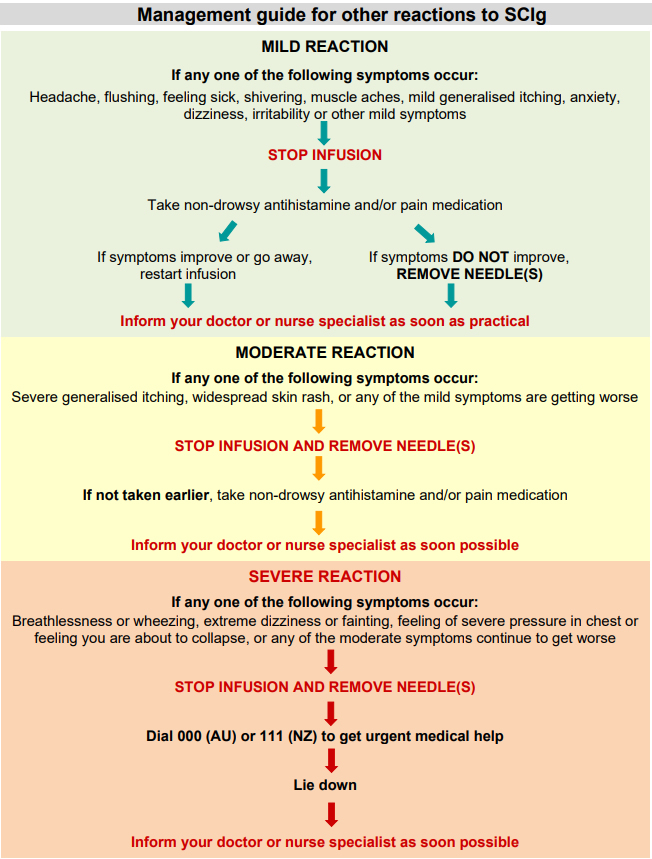
© ASCIA 2021
ASCIA is the peak professional body of clinical immunology and allergy specialists in Australia and New Zealand
Disclaimer
This document has been adapted with permission from resources developed by Princess Margaret Infirmary Immunology Section (Department of Health, Western Australia). It has been peer reviewed by ASCIA members and is based on skillful opinion and the bachelor published literature at the time of review. Information independent in this document is not intended to supersede medical advice and whatever questions regarding a medical diagnosis or treatment should be directed to a medical practitioner. Evolution of this document is not influenced past commercial organisations.
Content updated July 2021
How Long Do Lumps Stay In The Skin After Scig,
Source: https://www.allergy.org.au/patients/immunodeficiencies/scig-therapy-general-information
Posted by: holtthea1980.blogspot.com


0 Response to "How Long Do Lumps Stay In The Skin After Scig"
Post a Comment